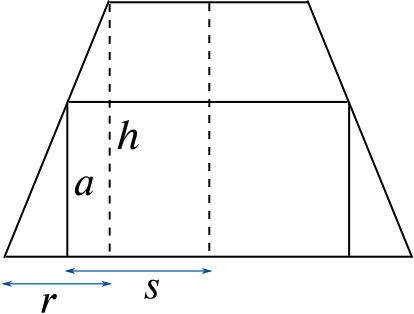
A truncated cone of height \(h\) has circular ends of radii \(2r\) and \(r\). In this cone is inserted a circular cylinder having its axis along the axis of the cone. One end of the cylinder lies in that face of the cone which is of radius \(2r\) and the circumference of the other end lies in the curved surface of the cone (see diagram). Given that the radius of the base of the cylinder is \(s\), show that the volume of the cylinder is
\[\frac{\pi h s^2(2r - s)}{r}.\]
The volume of a cylinder is given by (area of the base)\(\times\)(height).
Since the radius of the cylinder is \(s\), the area of its base is \(\pi s^2\).
We now need to find the height of the cylinder which we shall call \(a\). For this, consider the following cross section of the diagram above.

Thus the volume of the cylinder is \[\frac{\pi s^2 \times h(2r - s)}{r}\] as required.
If \(s\) is allowed to vary, find, in terms of \(h\) and \(r\), the maximum volume of the cylinder.
Putting \(\dfrac{dV}{ds} = 0\), we have \[s = 0 \quad \text{ or } \quad 4-\frac{3s}{r} = 0.\]
The second case is clearly the one we require, giving \(s = \dfrac{4}{3}r\). This yields \[ V_{max} = \frac{32\pi r^2 h}{27}. \]

